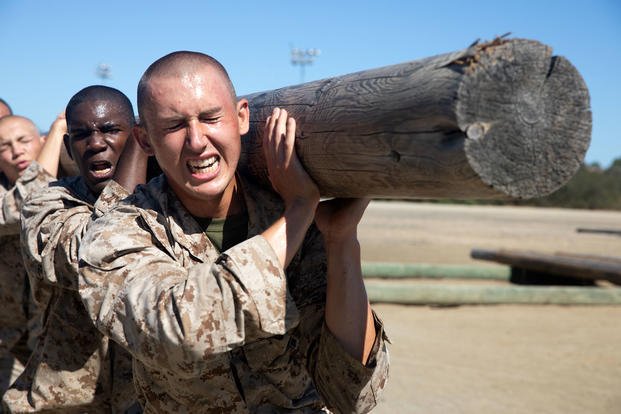We're approaching Memorial Day Murph season, and the questions are coming in about how to prepare for the high volume of calisthenics required to complete the event. Doing 100 pull-ups, 200 push-ups and 300 squats in a single workout is not something you should randomly attempt on a whim.
This type of calisthenics volume requires practice and a logical progression spread out over time, even if you are an avid exerciser. Have you ever done 100, 200 or 300 reps in a single workout before? How about recently?
Here is a question from a person who is already ready for the Murph but looking at pumping up some other numbers while doing the event.
Stew, I am starting to add more exercises to the Murph workout to make it harder by mixing in some Log PT preparation. Do you have a preferred structure for the Murph workout? Should I change up how I do it? How much weight are you pushing when doing log PT in a team? Do you recommend getting a log or using sandbags or water jugs instead? Terry
Terry, There is no need to overthink how to accumulate the 100 200 and 300 reps of the Murph. A few great ways to do that can be found in the Classic Military PT Week, where we use the PT Pyramid 1-10-1, PT superset and the max-rep set workout trio.
These workouts are also strategy options for completing the 100, 200 and 300 repetition requirements of the Murph. If you want to do the Murph and not feel it for days after or hurt yourself during the process, never do a set that takes you to complete max failure. Fatigue is one thing, but complete failure on a repetition may interfere with your ability to recover in a timely manner.
Most people prefer to do this kind of volume with sub-max-rep sets like the following:
Repeat 10 times.
Pull-ups: 10
Push-ups: 20
Squats: 30
Or double the sets and do half the reps each set with the following option:
Repeat 20 times.
Pull-ups: 5
Push-ups: 10
Squats: 15
To answer part two of your question, here are some ideas about adding in log PT exercises. If you think about the exercises that teams do when under a log, you can simulate those with a 40- to 50-pound sandbag.
Chest carry lunges per leg: 100
Chest carry sit-ups: 150
Shoulder carry squats: 150
Shoulder carry push press: 100
Run sets with a sandbag on the shoulder: 100-400 meters each set.
In fact, there is a workout we call the Sandbag Murph where you perform a Murph workout with extra exercises either mixed into the circuit or done after the Murph is completed. You can also opt to do this workout on a separate day from the Murph if this is too much total volume of push, pull, core and legs in one day for you.
We often choose a sub-max-set option when combining both workouts.
Repeat 10 times.
Pull-ups: 10
Push-ups: 20
Squats: 30
Chest carry sit-ups: 15
Chest carry lunges: 10 per leg
Shoulder carry push press: 10
Shoulder carry squats: 15
Run: 400 meters with sandbag
Do not set the sandbag on the ground, except for the original Murph exercises. The sandbag exercises are done in a non-stop circuit until you complete the last 400-meter run.
This takes an already advanced level workout and makes it even harder. I do not recommend trying any of the options above on a whim. Make sure you build up to a point where you are able to do 100 pull-ups and 200 push-ups in an upper-body workout without getting sore afterward.
The same goes for leg-day volume. Be able to accumulate 300 squats and lunge combinations as part of your normal weekly progressive workout routine. It may take some time to build up to this level, but this approach is ideal for anyone looking to do well in training programs where log PT is part of the challenge.
Stew Smith is a former Navy SEAL and fitness author certified as a Strength and Conditioning Specialist (CSCS) with the National Strength and Conditioning Association. Visit his Fitness eBook store if you're looking to start a workout program to create a healthy lifestyle. Send your fitness questions to stew@stewsmith.com.
Want to Learn More About Military Life?
Whether you're thinking of joining the military, looking for fitness and basic training tips, or keeping up with military life and benefits, Military.com has you covered. Subscribe to Military.com to have military news, updates and resources delivered directly to your inbox.


















